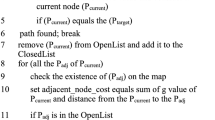Abstract
The paper addresses the problem of trajectory generation of a fixed-wing miniature aerial vehicle (MAV), constrained by a bounded turn rate, which is required to fly along a path defined by a series of waypoints in three-dimensional space. The generated trajectory named as γ-trajectory, transits between two consecutive waypoint segments in a “smooth” manner. For this trajectory the shortest distance from the waypoint can also be set to a desired value based on the limited capacity of the sensor mounted on the MAV. Subsequently, a loop-trajectory is generated, which is important if the vehicle is required to track the entire waypoint segments as well as the waypoints. Since the trajectory is composed of circles of minimum turn radius and straight lines, this is computationally fast and real-time implementable. Finally, the implementation of generated trajectory is illustrated in an environment cluttered with obstacles and several aspects of the generated trajectory are compared with those of the trajectories obtained using techniques available in the literature.
Similar content being viewed by others
References
Pettersson, P., Doherty, P.: Probabilistic roadmap based path planning for an autonomous unmanned helicopter. J. Intel. Fuzzy Syst. 17(4), 395–405 (2006)
Lee, D.T., Schachter, B.J.: Two algorithms for constructing a Delaunay triangulation. Int. J. Comput. Inf. Sci. 9(3), 219–242 (1980)
LaValle, S.M.: Rapidly-exploring Random Trees: A New Tool for Path Planning, TR 98-11, Computer Science Dept, Iowa State University (1998)
Anderson, E.P., Beard, R.W., McLain, T.W.: Real-time dynamic trajectory smoothing for unmanned air vehicles. IEEE Trans. Control Syst. Technol. 13(3), 471–477 (2005)
Hota, S., Ghose, D.: Optimal transition trajectory for waypoint following. In: IEEE Conference on Control Applications, pp. 1030–1035. Hyderabad (2013)
Hota, S., Ghose, D.: Curvature-constrained trajectory generation for waypoint following. Proc. Inst. Mech. Eng. Part G: J. Aerospace Eng. 228(11), 2066–2082 (2013)
Saunders, J.B., Call, B., Curtis, A., Beard, R.W., McLain, T.W.: Static and dynamic obstacle avoidance in miniature air vehicles. Infotech@ Aerospace. Arlington, AIAA 2005-6950 (2005)
Whang, I.H., Hwang, T.W.: Horizontal waypoint guidance design using optimal control. IEEE Trans. Aerospace Electron. Syst. 38(3), 1116–1120 (2002)
Samar, R., Kamal, W.A.: Optimal path computation for autonomous aerial vehicles. Cogn. Comput. 4(4), 515–525 (2012)
Babaei, A.R., Mortazavi, M.: Fast trajectory planning based on in-flight waypoints for unmanned aerial vehicles. Aircraft Eng. Aerospace Technol. 82(2), 107–115 (2010)
Dubins, L.E.: On curves of minimal length with a constraint on average curvature and with prescribed initial and terminal positions and tangents. Amer. J. Math. 79, 497–516 (1957)
Liu, C.-a., Cheng, W.-g., Hong, Z.: A trajectory generator for a mobile robot in 3D path planning. In: Proceedings of the IEEE International Conference on Automation and Logistics, pp. 1247-1251. Jinan (2007)
Lee, S.K., Lee, S., Nam, C., Doh, N.L.: Local path planning scheme for car-like vehicle’s shortest turning motion using geometric analysis. In: IEEE/RSJ International Conference on Intelligent Robots and Systems, pp. 4762–4768. Taipei (2010)
Sahingoz, O.K.: Generation of Bezier curve-based flyable trajectories for multi-UAV systems with parallel genetic algorithm. J. Intel. Robot. Syst. 74(1), 499–511 (2013)
Elbanhawi, M., Simic, M., Jazar, R.N.: Continuous path smoothing for car-like robots using B-spline curves. J. Intel. Robot. Syst. 80(Suppl 1), S23–S56 (2015)
Yang, K., Sukkarieh, S.: An analytical continuous-curvature path-smoothing algorithm. IEEE Trans. Robot. 26(3), 561–568 (June 2010)
Yang, K., Sukkarieh, S.: 3D smooth path planning for a UAV in cluttered natural environments. In: Proceedings of the IEEE/RSJ International Conference on Intelligent Robots and Systems, pp. 794–800. Nice (2008)
Shanmugavel, M., Tsourdos, A., White, B.A.: Collision avoidance and path planning of multiple UAVs using flyable paths in 3D. In: 15th International Conference on Methods and Models in Automation and Robotics (MMAR), pp. 218–222 (2010)
Tsourdos, A., White, B.A., Shanmugavel, M.: Cooperative Path Planning of Unmanned Aerial Vehicles. Wiley Publication (2011)
Sussmann, H.J.: Shortest 3-dimensional paths with a prescribed curvature bound. In: 34th IEEE Conference on Decision and Control, pp. 3306–3312. New Orleans (1995)
Hota, S., Ghose, D.: Optimal spatial path planning for an unmanned aerial vehicle. J. Aircraft 51(2), 681–688 (2014)
Doshi, A.A., Singh, S.P.N., Postula, A.J.: An online motion planning and control strategy for UAVs in wind using reduced order forward models. In: Proceedings of Australasian Conference on Robotics and Automation. Sydney (2013)
Hota, S., Ghose, D.: Rectilinear path following in 3D space. In: Vadakkepat, P., Kim, J.-H. (eds.) Trends in Intelligent Robotics, Communications in Computer and Information Science, vol. 103, pp. 210–217. Springer-Verlag, Berlin (2010)
Hota, S., Ghose, D.: Optimal trajectory planning for path convergence in 3D space. Proc. Inst. Mech. Eng. Part G: J. Aerospace Eng. 228(5), 766–780 (2013)
Anderson, J.D.: Introduction to Flight, 5th edn. Tata McGraw hill (2005)
Author information
Authors and Affiliations
Corresponding author
Rights and permissions
About this article
Cite this article
Hota, S., Ghose, D. Waypoint-Based Trajectory Planning of Fixed-Wing MAVs in 3D Space. J Intell Robot Syst 86, 95–113 (2017). https://doi.org/10.1007/s10846-016-0415-3
Received:
Accepted:
Published:
Issue Date:
DOI: https://doi.org/10.1007/s10846-016-0415-3




